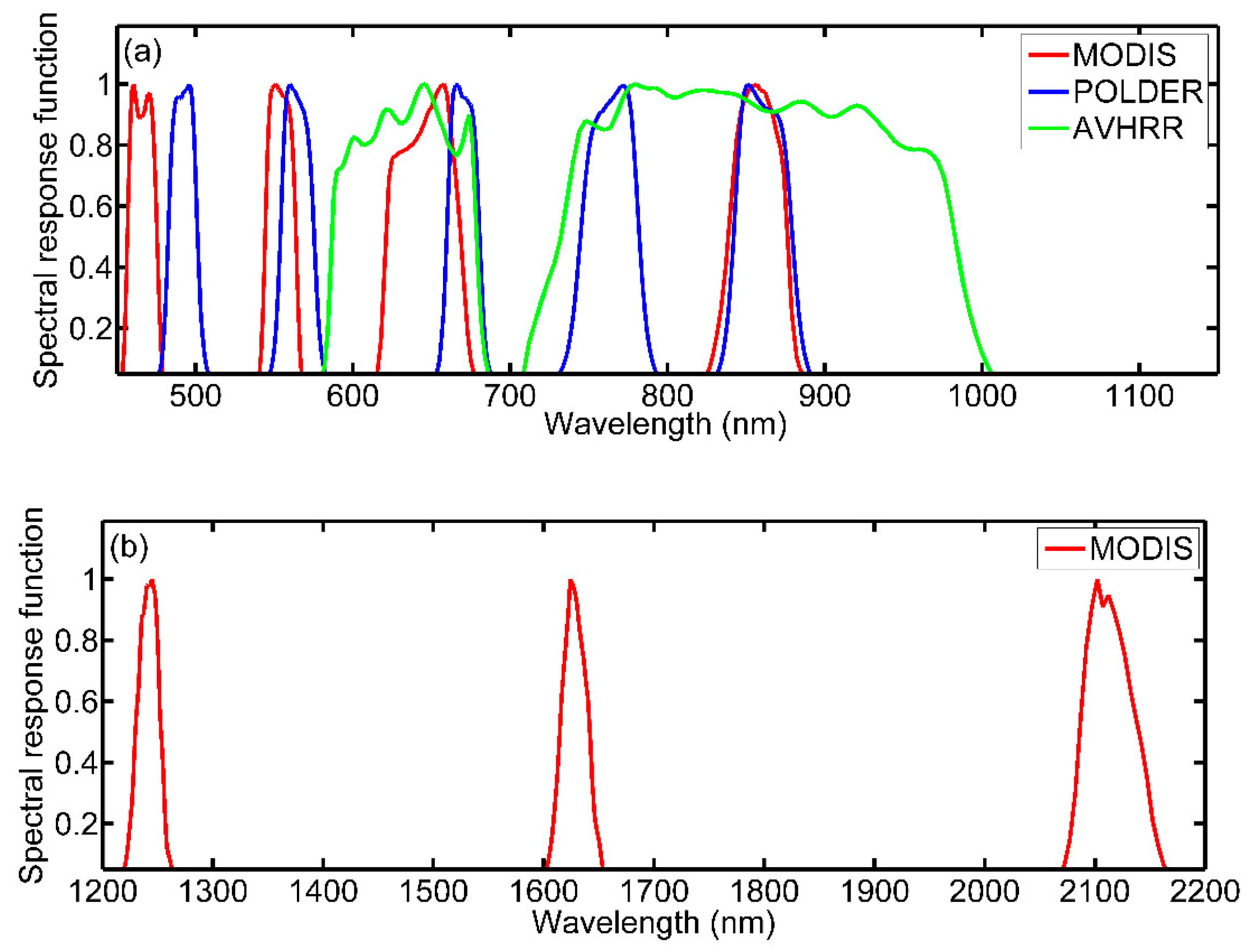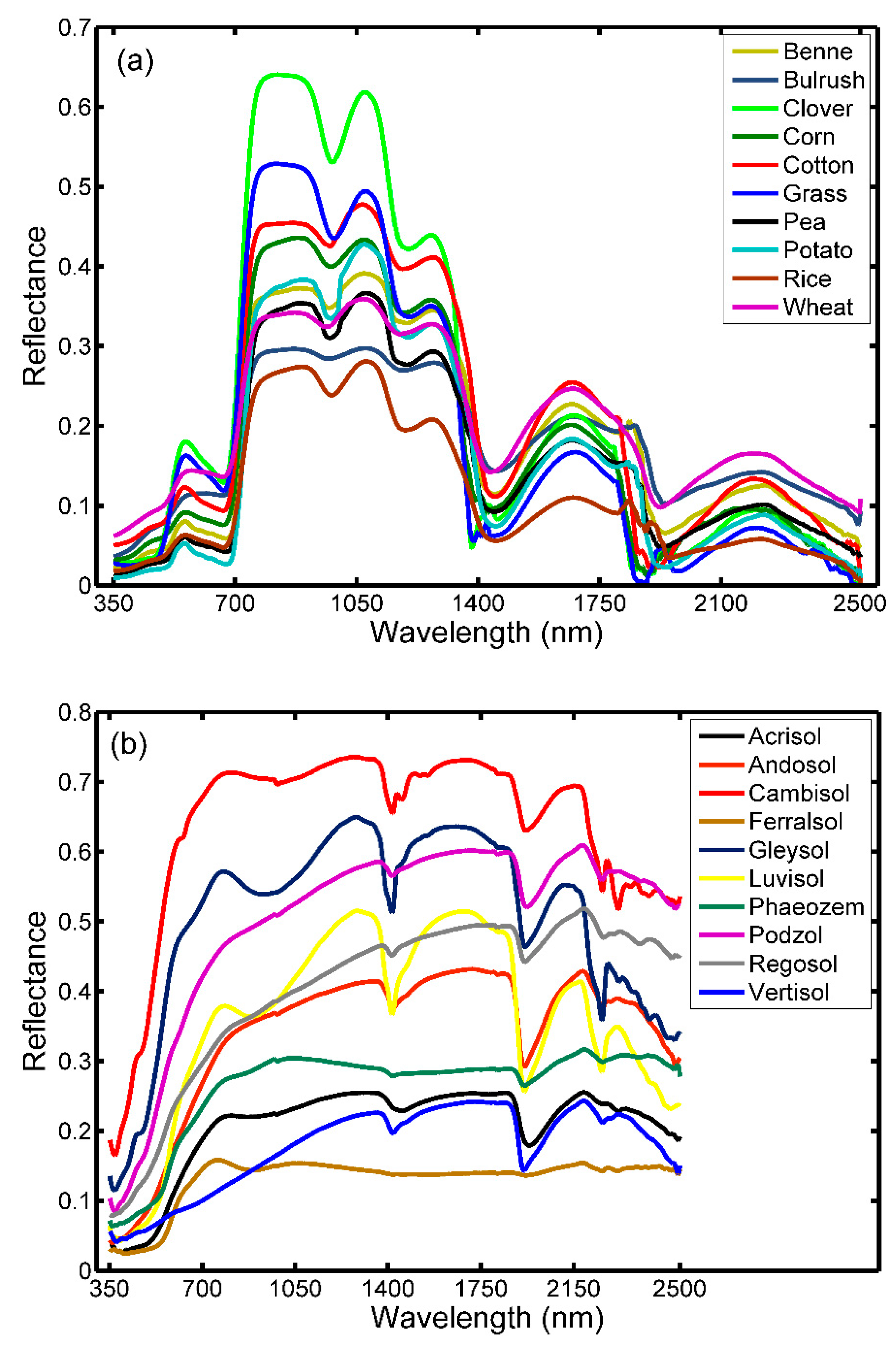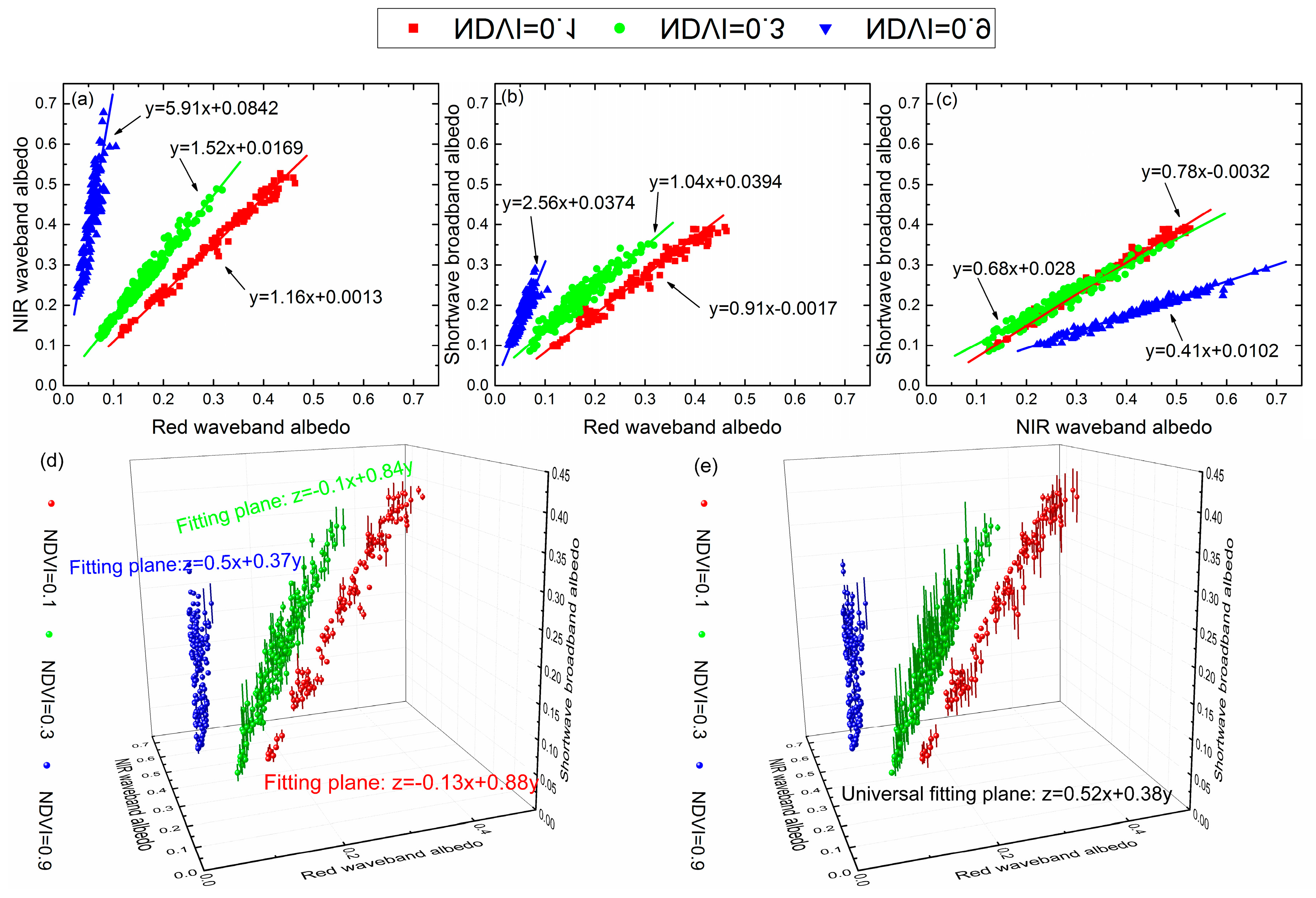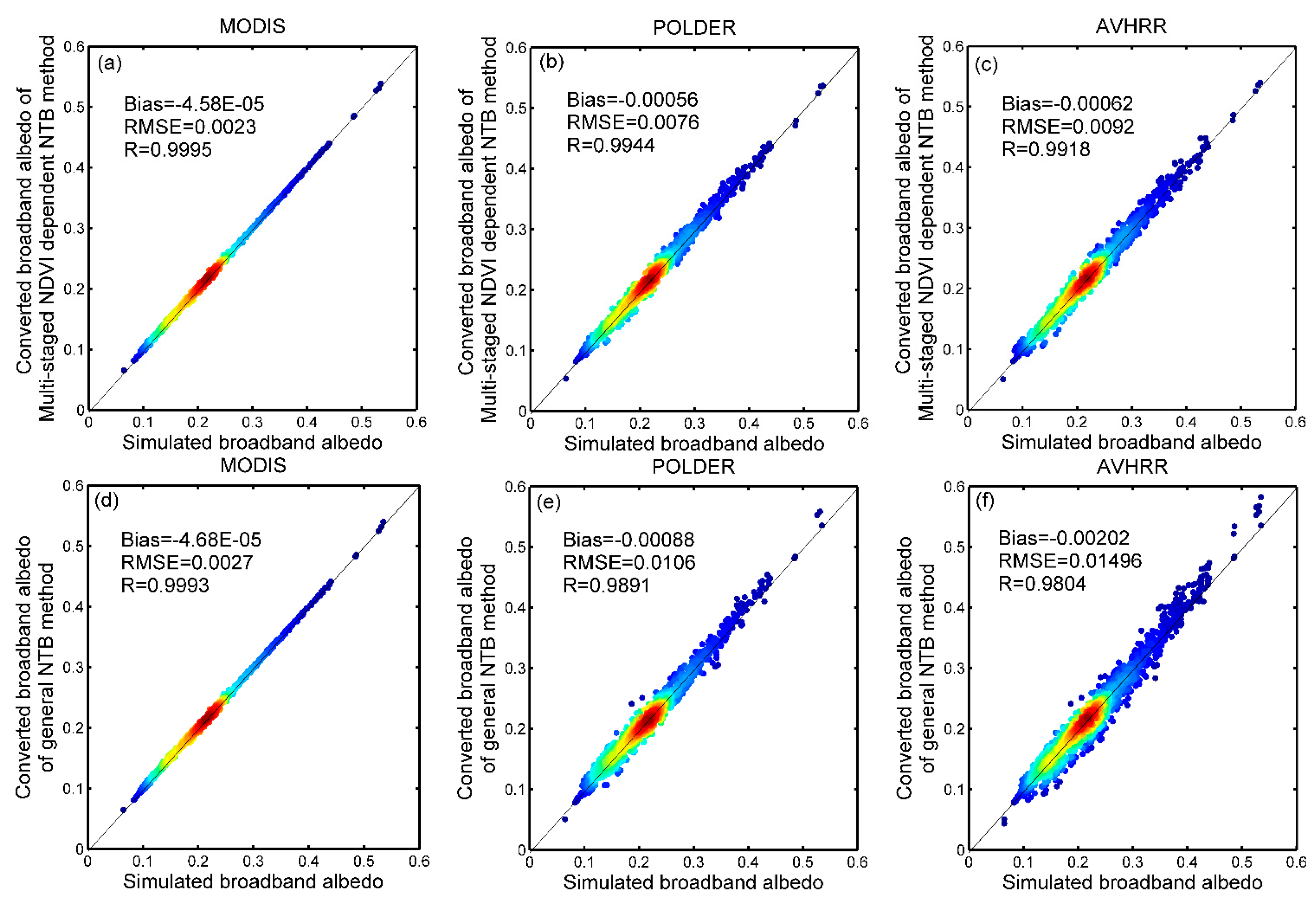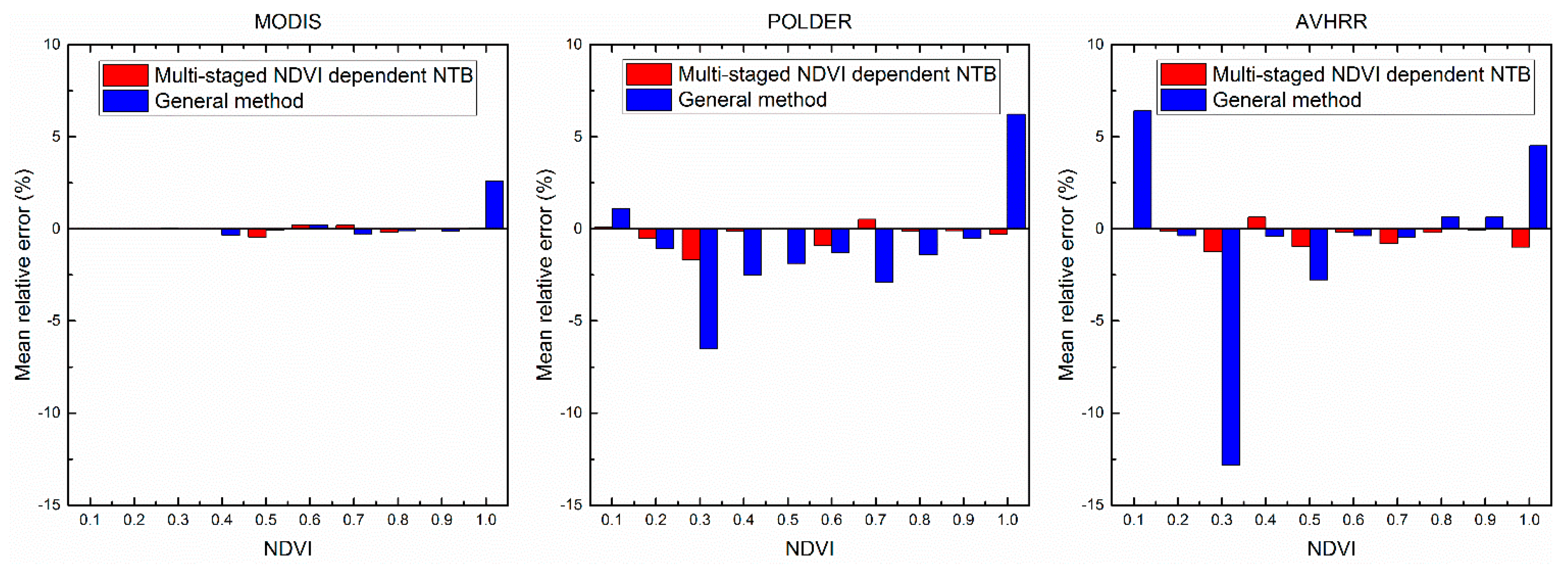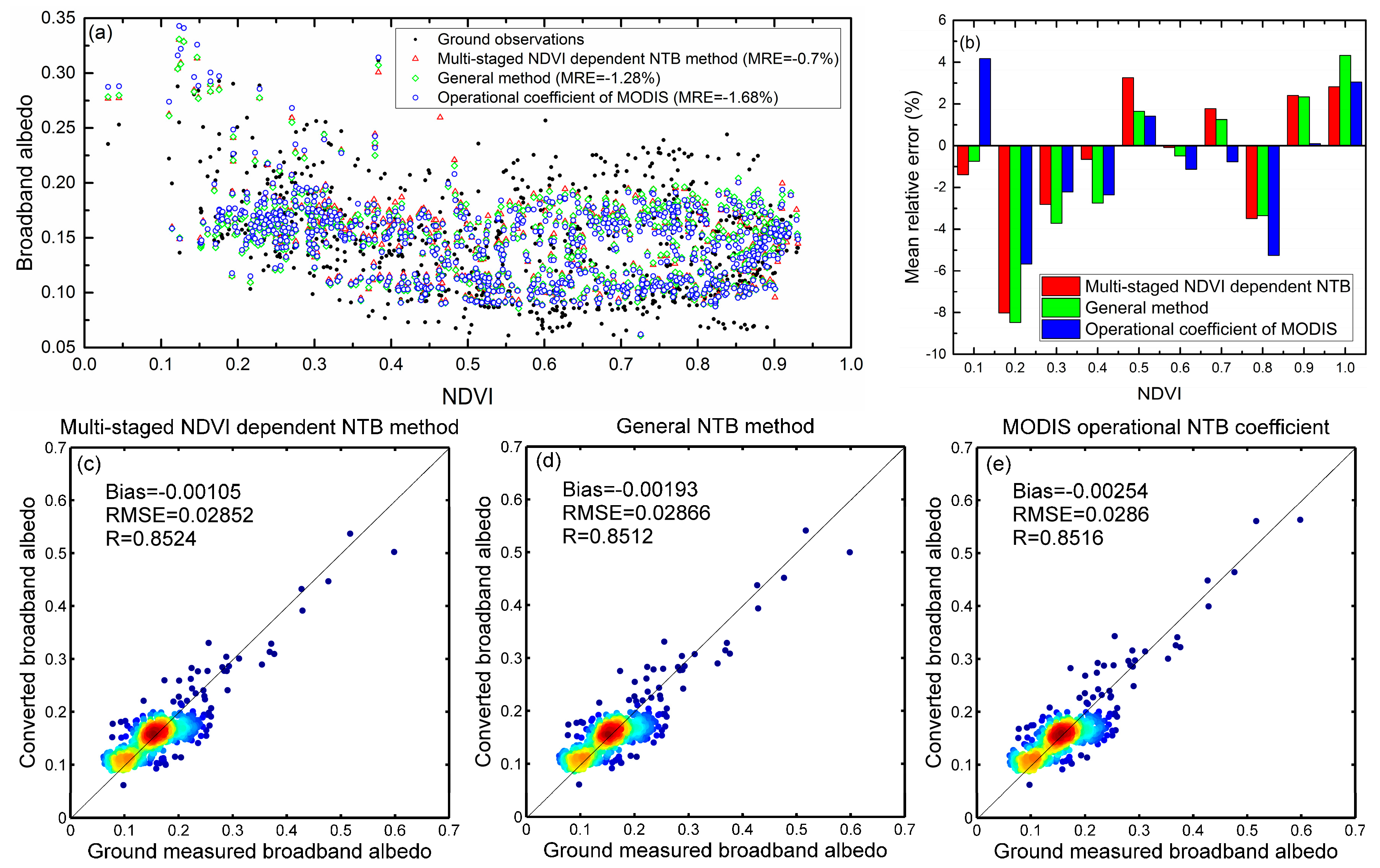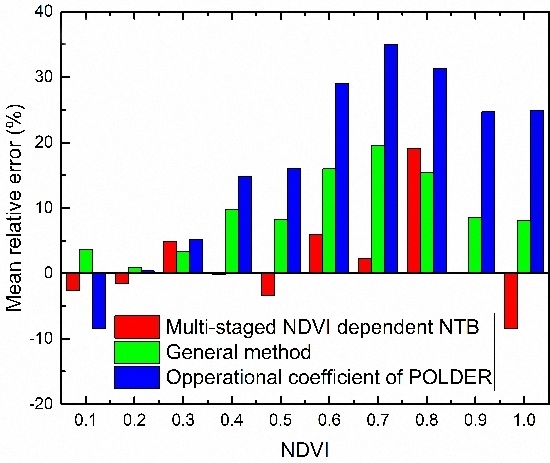1. Introduction
Land-surface broadband albedo is a critical parameter in the energy budget, the climate model, the evapotranspiration estimation and in global change, and it is quantified as the fraction of solar radiation reflected by the earth’s land surface [
1,
2,
3,
4,
5]. Thus, albedo is relative to land-surface reflectance, which can be described using the Bidirectional Reflectance Distribution Function (BRDF) [
6]. When integrating directional reflectance to hemispherical albedo, satellite remote sensing provides the most practical way to consistently map land-surface albedo. Recent middle- and low-resolution remote sensors, such as Moderate Resolution Imaging Spectroradiometer (MODIS) [
7], Polarization and Directionality of Earth’s Reflectance (POLDER) [
8], and Advanced Very High Resolution Radiometer (AVHRR) [
9], provide important data from which to produce global land-surface albedo using the BRDF model [
10,
11,
12].
However, these satellite sensors do not always have a consistent spectral band and sometimes have several limited narrowband wavelengths. To obtain shortwave band-length albedo, conversion coefficients are usually used for inverting narrowband albedo to broadband albedo, which is a crucial step in the land-surface albedo estimation using remote-sensing images [
13].
Early research to derive the conversion coefficients for AVHRR and Landsat were mainly dependent on field or top-of-atmosphere (TOA) measurements [
14,
15,
16,
17]. Model simulation is preferable for calculating conversion coefficients because ground measurements are expensive under different atmospheric and surface conditions [
18]. Thus, conversion coefficients for most sensor systems, such as MODIS, Multi-angle Imaging SpectroRadiometer (MISR), Medium Resolution Imaging Spectrometer (MERIS), POLDER, and Visible/Infrared Imager/Radiometer Suite (VIIRS), are all based on similar simulation methods [
19,
20,
21,
22,
23]. The basic method establishes the multiple linear regression relationship between narrowband and broadband albedos, which is influenced by both the surface reflectance characteristic and atmospheric condition.
Land-surface albedos from various remote sensors were simulated under a series of different atmospheric conditions, and the conversion coefficients were calculated and validated [
18,
24]. The influence of the surface reflectance characteristic is challenging to determine because individual land-surface type regressions have significantly different characteristics [
25]. Thus, NTB regression should be divided into a series of sets for different surface types. Some global albedo products, such as MODIS, POLDER and CYCLPES, have divided their conversion coefficients into snow and snow-free, two types to emphasize the unusual reflective characteristic of snow surfaces [
10,
11,
26]. However, NTB conversion on snow-free ground is also strongly dependent on the surface types due to the great difference in optical reflectance between soil and vegetation. Land-surface classification is a straightforward method by which to distinguish surface types, but the variability of land cover due to vegetation phenology makes it difficult to capture the surface type instantaneously [
27]. Furthermore, the land surface reflectance, which plays a very significant role in the NTB conversion, has been proven to be related to the Normalized Difference Vegetation Index (NDVI). Furthermore, the NDVI-based disaggregation technique has been evaluated to be a more effective strategy than the land cover based technique or the crop type based technique in the research field of BRDF-adjustment [
28,
29,
30]. Thus, NDVI is considered the most suitable parameter for analyzing and solving the impact of the surface reflectance characteristic to NTB conversion [
31]. A previous study used NDVI as a variable to build quadratic polynomials to calculate the red and infrared bands’ conversion coefficients [
32]. This method is a desirable solution for sensor with only these two bands such as AVHRR, but may not be suitable for other sensors with more than these two bands. In general, NTB coefficient regression is more robust when information from multiple bands are used compared with the same calculation using two or fewer bands. Thus, for sensors with more than red and infrared bands, using such quadratic polynomials to calculate the conversion coefficients will reduce the information from multiple bands, which will introduce more uncertainties. Moreover, the accuracy of such method may be unstable, because the NDVI error can be directly propagated into the calculated conversion coefficients by the quadratic polynomials.
In this study, we used a NDVI dependent disaggregation look up table method to generate the multi-staged NTB coefficients of different NDVI classes of MODIS, POLDER and AVHRR broadband albedo estimation, whose band numbers were 7, 5 and 2, respectively. This method considers both the multiple band information and land-surface type, so that all of the sensors’ band information can be used to understand the different land-surface reflectance characteristics. Furthermore, the indirect approach to couple NTB coefficient with NDVI can avoid the direct error-propagation. A sensitivity analysis was performed to assess the effect of NDVI on NTB conversion and its relationship with the sensor’s placement and number of wavebands. The result is significant for determined whether a remote sensor is necessary to consider the different surface reflectance characteristics during its NTB conversion approach.
In this paper, we first address the theoretical basis of the multi-staged NDVI dependent NTB method in
Section 2, followed by the description of data in
Section 3. Further, we provide the NTB coefficients derived by the new method, and their sensitivity analyses and accuracy evaluations results in
Section 4. Then we discuss the results in detail in
Section 5. Finally, we present a summary in
Section 6.
5. Discussion
We have proposed the multi-staged NDVI dependent NTB coefficient for MODIS, POLDER and AVHRR to better address conversion performances on different surface types. The accuracy evaluation results indicated that, by using the multi-staged NDVI dependent NTB method, the conversion accuracies of the three sensors were improved in comparison with the general method and the operational coefficients of global albedo products, but the improvements are related with the placement and number of sensor waveband and the spatial resolution of global albedo product. For MODIS, the results of these two methods were not much different. On the one hand, as demonstrated in
Section 4.2, the sensitivity of the NDVI to NTB conversion of MODIS is very low. On the other hand, the seven bands (wavelength spanning from 0.47 µm to 2.15 µm) and 500 m spatial resolution of MODIS are adequate to capture the surface reflectance variations of different ground scenes at the tower-based flux site observation scale. Therefore, one can confirm that the impact of NDVI-to-NTB conversion is low for sensors like MODIS and VIIRS whose waveband number is more than 7, and the universal NTB coefficients derived by general method are suggested to be adequate for these sensors. However, for POLDER and AVHRR, the improvement tends to be much more significant while their fitting accuracy of the general method appeared to decrease sharply. It is therefore indicated that five or two bands (wavelength ranging from 0.47 µm to 1 µm) are insufficient for ignoring the influence caused by the different surface reflectance characteristics in NTB conversion. The NDVI can impact the NTB conversion significantly (by 2% to 35% improvement of conversion accuracy) for the sensors like POLDER and AVHRR whose waveband number is less than 5. Thus, it is necessary to adopt the proposed multi-staged NDVI dependent NTB coefficient LUTs for POLDER and AVHRR. Furthermore, with the advance of satellite observation technologies, high resolution multispectral remote-sensing systems such as QuickBird, IKONOS, SPOT, ALOS, FORMOSAT, HJ and GF have become one of the main trends in the development of remote sensing. These sensors usually have only four wavebands. Therefore, the proposed multi-staged NDVI dependent NTB method has great potential in the application of these high resolution remote sensors.
It should be noted that this study selected NDVI to stratify the coefficient LUTs, which might be not sensitive to some surface types due to its saturation effect. However, this problem does not greatly affect the albedo’s NTB conversion because the variation of the surface spectral characteristics is small when the NDVI was greater than 0.7. Other indices, such as the LAI or reflectance combination of other wavebands, could also be used with this method, as long as they are easy to calculate and beneficial for identifying accurately the different surface types.
This paper was based on the land surface Lambertian assumption, the effect of the angular anisotropy of land surface reflectance were not addressed in detail. This is mainly because the high quality surface spectral albedo or BRDF data of multiple land cover types are difficult to obtain, and the available spectral albedo data are insufficient to derive representative NTB coefficient with reliable accuracy. Therefore, our further research will focus on finding how the BRDF affects the NTB conversion, and with the accumulation of spectral albedo based on the in situ measurement as well as the radiation transfer modelling, the comprehensive and quantitative research of the NTB conversion will be performed in the future. The other assumption used in this paper was the vacuum atmosphere condition. Although the effect of the atmosphere condition on the NTB conversion was relatively slight in the total shortwave [
18], it is also a research aspect in the future.
6. Conclusions
In this paper, using multiple linear regression of simulated narrowband and broadband albedos under various NDVI stratified surface types, multi-staged NDVI dependent NTB coefficient LUTs were developed for three sensors with different band numbers: MODIS, POLDER and AVHRR. The conversion accuracy of the multi-staged NDVI dependent NTB method was validated by evaluating the agreements between the converted surface broadband albedos using simulations and in situ measurements. This validation was also implemented for the conversion coefficients of general methods. Comparative analyses of the validation results of multi-staged NDVI dependent and general NTB methods revealed that the NDVI is sensitive to land-surface albedo NTB conversion, especially for sensors with fewer bands, such as POLDER and AVHRR. The conversion accuracies of these two sensors were effectively improved using the new method proposed in this paper that couples the NTB coefficients with the NDVI.
In the future, investigations should be conducted to extend the application of the multi-staged NDVI dependent NTB method to global mainstream remote-sensing sensors with four or five bands. Additionally, future studies should optimize the coefficient LUTs by taking into account the effects of the bidirectional reflectance characteristic using simultaneous in situ measurements of multi-angle reflectance spectra and broadband albedos. Finally, a comprehensive validation should be given for the albedo’s NTB coefficient.
